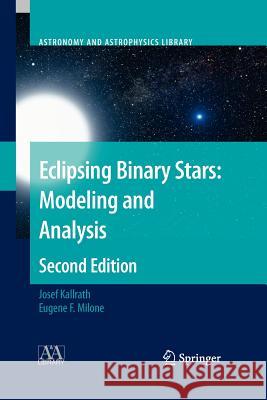Eclipsing Binary Stars: Modeling and Analysis » książka
Eclipsing Binary Stars: Modeling and Analysis
ISBN-13: 9781461429289 / Angielski / Miękka / 2012 / 420 str.
Have you ever stopped at a construction project on the way to your of?ce and the day's astrophysics? Remember the other onlookers - folks just enjoying the sp- tacle, as we all do in following developments away from our areas of active work? We are excited and thrilled when the Hubble Space Telescope discovers an Einstein Cross, when the marvelous pulsars enter our lives, and when computer scientists put a little box on our desk that outperforms yesterday's giant machines. We are free to make use of such achievements and we respect the imagination and discipline needed to bring them about, just as onlookers respect the abilities and planning needed to create a building they may later use. After all, each of us contributes in our own areas as best as we can. In addition to the serious onlookers there will be passersby who take only a casual look at the site. They may use the building later, but have little or no interest in its construction and give no thought to the resources needed to bring it to completion. Upon arriving at work, those persons write astronomy and astrophysics books at various levels, in which they must say something about close binary stars. Usually a page or two will do, and the emphasis is on the MLR (mass, luminosity, radius) data obtained only from binaries.
Eclipsing Binary Stars focuses on the mathematical formulation of astrophysical models for the light curves of eclipsing binaries stars, and on the algorithms for evaluating and exploiting such models. Since information gained from binary systems provides much of what we know of the masses, luminosities, and radii of stars, such modeling is acquiring increasing importance in studies of stellar structure and evolution. As in other areas of science, the computer revolution has given many astronomers tools that previously only specialists could use; anyone with access to a set of data can now expect to be able to model it. This book will provide astronomers, both amateurs and professionals, with a guide for specifying an astrophysical model for a set of observations selecting an algorithm to determine the parameters of the model estimating the errors of the parameters§Eclipsing Binary Stars is written for readers familiar with basic calculus and linear algebra; appendices cover mathematical details on such matters as optimization, coordinate systems, and specific models. This 2nd edition includes new physics in light curve models and distance fitting and implications on T1. Other improvements include, new features in the WD program, new applications in astronomy and astrophysics, new literature cases, Milone's papers and new software developments in the eclipsing binary community.











